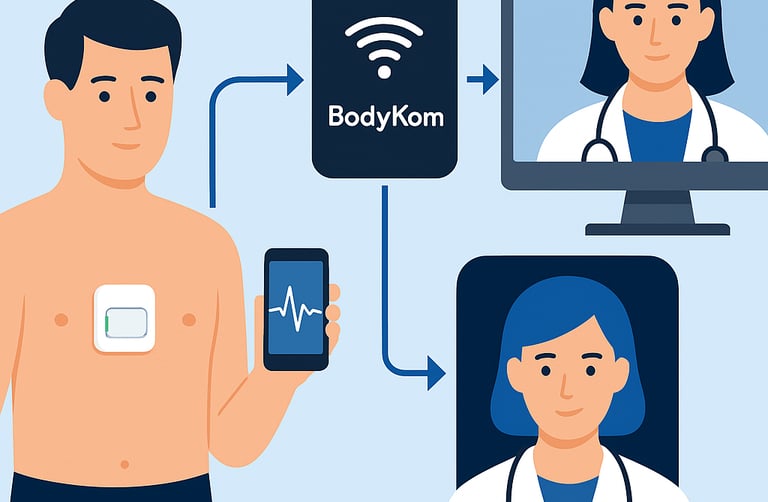Mobile Monitoring vs. Traditional Holter Monitors: Which Wins?
When it comes to diagnosing cardiac arrhythmias and monitoring heart health, continuous ECG monitoring remains the cornerstone of non-invasive cardiac diagnostics. For decades, the Holter monitor has been the gold standard in ambulatory cardiac monitoring. However, with the emergence of mobile ECG monitoring solutions like BodyKom, the game is changing. This blog offers a head-to-head comparison of mobile cardiac monitoring systems and traditional Holter monitors to determine which solution better serves today’s patients and clinicians.
4/5/20252 min read


What is a Holter Monitor?
A Holter monitor is a portable ECG device typically worn for 24 to 48 hours. Electrodes are attached to the chest, and the data is recorded on a device clipped to the patient’s belt or worn on a strap. After the monitoring period, the patient returns the device to the clinic, where the data is analyzed retrospectively.
While effective, Holter monitors are limited in their capacity to capture infrequent or transient arrhythmias, and their reliance on post-recording analysis delays clinical response.
What is BodyKom?
BodyKom is a mobile, real-time cardiac monitoring solution that uses a wearable ECG sensor to transmit data continuously via mobile networks. This system allows clinicians to monitor patients remotely, receive instant alerts for abnormalities, and intervene proactively.
BodyKom enables long-term monitoring in real-world settings without tethering the patient to static hardware or requiring physical return of devices for data retrieval.
Feature-by-Feature Comparison
Feature Holter Monitor BodyKom Mobile Monitoring
Monitoring Duration 24–48 hours Days to weeks (continuous)
Data Transmission Offline, retrospective Real-time via mobile network
Clinical Response Time Delayed (post-analysis) Immediate alerts and action
Patient Mobility Limited by wires and device Fully mobile and discreet
Alert Customization Not available Clinician-set personalized thresholds
Symptom Correlation Requires patient diary Real-time symptom tagging via app
Infrastructure Needs Device return, in-clinic analysis Cloud-based dashboard for remote access
Clinical Advantages of BodyKom
Early Detection of Intermittent Events
Many arrhythmias, such as paroxysmal atrial fibrillation (PAF), occur sporadically and may not manifest during a short Holter monitoring period. Mobile monitoring allows for extended data capture, improving detection rates (Steinhubl et al., 2021).
Real-Time Clinical Intervention
BodyKom can trigger automated alerts when a threshold is crossed—whether it’s ST-segment depression, tachycardia, or pauses—enabling timely medical action (Johnson et al., 2021).
Patient-Centered Design
Unlike Holter monitors, BodyKom’s form factor allows patients to shower, exercise, and continue normal routines, improving adherence and comfort.
Chronic Disease Management
For long-term monitoring of heart failure, post-MI patients, or those on beta blockers, BodyKom offers scalable, home-based care solutions.
Limitations and Considerations
Factor Holter Monitor BodyKom
Cost Generally lower Higher initial costs but more value over time
Technical Requirements Minimal Requires mobile coverage and cloud infrastructure
Data Volume Manageable Requires intelligent filtering and storage management
Verdict: Which Wins?
Holter monitors remain useful for short-term diagnostics and in low-resource settings. However, in today’s connected healthcare environment, BodyKom and similar mobile monitoring platforms offer clear advantages in:
Real-time detection and intervention
Long-term patient monitoring
Improved diagnostic yield
Patient convenience and lifestyle integration
For clinicians and healthcare systems seeking to improve outcomes, reduce hospitalizations, and embrace data-driven care, mobile ECG monitoring is the future.
References
Steinhubl, S. R., Waalen, J., Edwards, A. M., et al. (2021). “Effect of a Home-Based Wearable Continuous ECG Monitoring Patch on Detection of Undiagnosed Atrial Fibrillation.” JAMA Network Open, 4(1):e2031326.
Johnson, K. W., et al. (2021). “Artificial Intelligence in Cardiology.” Journal of the American College of Cardiology, 77(3), 319–331.
Goldberger, J. J., et al. (2019). “Ambulatory Arrhythmia Monitoring: Choosing the Right Device.” Circulation: Arrhythmia and Electrophysiology, 12(1), e007124.
